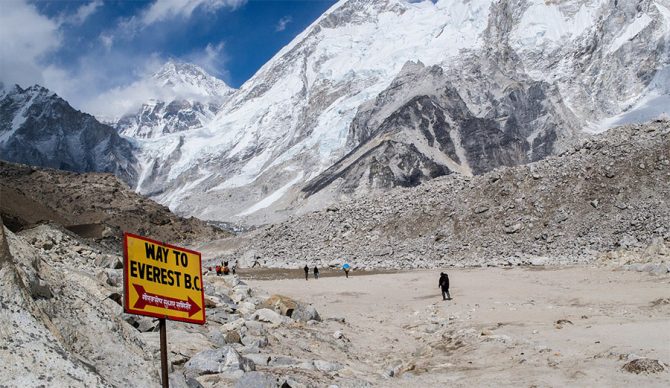
Big changes coming to base camp. Photo: Wikimedia Commons
A sweeping list of reforms have been announced in Nepal that are aimed to clean up its high altitude trash problem and increase safety for climbers and guides alike. The new regulations come as the result of increased casualties on Mt. Everest, particularly after 2023 tied for the deadliest season on record with 17 deaths.
However, the reforms – which include how to manage human feces, trash, and dead bodies, as well as helicopter use, tent footprints, and base camp access – have undergone a series of last-minute revisions that have left guide companies dizzied just prior to the start of the 2024 Everest season.
The Khumbu Pasang Lhamu Rural Municipality in Nepal, whose jurisdiction includes several mountains including Mt. Everest, first came out with the new set of regulations on Feb 8. The municipality announced the new additions to the guidelines on February 14 and 28, and then relaxed on some of the more stringent policies on March 8.
Many of the regulations were aimed at reducing waste on the mountain – particularly in the difficult-to-manage high altitude camps. Nepal’s Tourism Department estimates that there are more than 140,000 tons of trash on Everest alone, including three tons of human excrement.
Climbers will be required to purchase poop bags and carry them throughout the journey back to base camp. Guide groups will have to carry inventory lists to ensure that all items brought up mountains are also brought down. Additionally, every climber on Everest (or Mt. Nuptse and Mt. Lhotse) will be required to return with at least eight kilograms (17.6 pounds) of trash. And in a drastic change from the past, expedition companies will be required to retrieve any bodies from deceased members of their group. Only once any such bodies are extricated from the mountain can the company receive their “Garbage Clearance Letter.”
As far as logistics of gear, the regulations released also plan to limit the use of helicopters, while encouraging wider use of porters and yaks to transport supplies. Originally limiting helicopter access to an area 30 minutes below the base camp, the revised rules now will allow helicopter access to base camp subject to clearance of a monitoring committee. The purpose of the rule is to reduce noisy helicopter traffic, but also to promote the region’s yak herding industry and cultural practice. However, according to some guides, there simply aren’t enough yaks to make this rule practical.
“If this (helicopter) regulation is not relaxed, we will see chaos – teams not getting gear, food, and oxygen to the mountain in time,” Austrian guide Lukas Furtenbach told Outside.
The restrictions also limit the size of tents – 60 square feet for dining tents and 80 square feet per person for sleeping tents, an increase from the original announcement requiring dining tents not exceed 10 square feet per person. Box tents will not be allowed above base camp. Furtenbach does not think that this rule will achieve the desired outcome.
“We might see a base camp this year with more tents than ever because of the new regulations,” Furtenbach added.
General visitors will not be allowed to stay the night at base camp, only permitted hikers and staff. The updated eased restrictions will allow for friends and family of climbers, as well as medical staff. (The original rule that has since been amended required that expedition medical staff at base camp purchase a climbing permit to gain access.) Finally, the use of brand new ropes will be mandatory when fixing the climbing routes.
The new restrictions to curb waste come during a push to remove trash from Everest and surrounding mountains in Nepal.
“The Nepali Army, in collaboration with local authorities and stakeholders, is also making preparations for the next mountain cleanup campaign and it is expected that at least five dead bodies will be retrieved from Mt Everest and Nuptse,” Rakesh Gurung, Director of the Department of Tourism, told The Himalaya Times.
While the new set of rules released with such short notice before climbing season appears to be a major inconvenience for expeditions, the purpose of the guidelines comes from a good place: to increase climber safety and reverse the starling trend of trash build-up on the top of the world.

